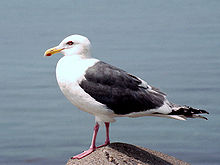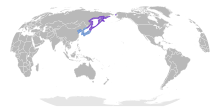Slaty-backed gull
| Slaty-backed gull | |
|---|---|

| |
| Scientific classification | |
| Kingdom: | Animalia |
| Phylum: | Chordata |
| Class: | Aves |
| Order: | Charadriiformes |
| Family: | Laridae |
| Genus: | Larus |
| Species: | L. schistisagus
|
| Binomial name | |
| Larus schistisagus Stejneger, 1884
| |

| |
The slaty-backed gull (Larus schistisagus) is a large, white-headed gull that breeds on the north-eastern coast of the Palearctic, but travels widely during nonbreeding seasons. It is similar in appearance to the western gull and the glaucous-winged gull. Another alternate name is Pacific gull, though it also applies to a Southern Hemisphere species, L. pacificus.
Distribution and habitat[]
Claims have been made as to its (sometimes occasional) presence throughout North America. as well as the eastern coast of temperate Asia (Palearctic). On 3 November 2012, an individual was spotted in Finland. The species has only been spotted three times before in Europe.[2]
Description[]
It is tied with the yellow-footed gull for fourth-largest gull species, measuring 55–68.5 cm (21.7–27.0 in) in length, 132–160 cm (52–63 in) in wingspan, and 1.05–1.7 kg (2.3–3.7 lb) in weight.[3][4] Among standard measurements, the wing chord is 40 to 48 cm (16 to 19 in), the bill is 4.8 to 6.5 cm (1.9 to 2.6 in), and the tarsus is 6 to 7.6 cm (2.4 to 3.0 in).[4] It has a white head, belly, and tail with a dark slaty-gray back and wings with a broad white trailing edge. The wings and back are slightly darker than those of the western gull. The undersides of the wings feature a "string of pearls" pattern along their edges; these can be seen from below when the bird is in flight. Its eyes are yellow. The legs are pink and short when compared with those of similar-looking gulls, and the body appears more stout. The bill is yellow with orange-red subterminal spot (the spot near the end of the bill that chicks peck to stimulate regurgitative feeding). Immature gulls' plumage is brown, similar to that of the great black-backed gull, but paler, and is practically indistinguishable from the immature herring gull in the field.[citation needed]
Etymology[]
The genus name is from Latin larus, which appears to have referred to a gull or other large seabird. The specific schistisagus is from New Latin schistus, "slate", and Latin sagus, "cloak".[5]
References[]
- ^ BirdLife International (2012). "Larus schistisagus". IUCN Red List of Threatened Species. 2012. Retrieved 26 November 2013.
- ^ MTV3 News website
- ^ CRC Handbook of Avian Body Masses by John B. Dunning Jr. (Editor). CRC Press (1992), ISBN 978-0-8493-4258-5.
- ^ Jump up to: a b Gulls: Of North America, Europe, and Asia by Klaus Malling Olsen & Hans Larsson. Princeton University Press (2004). ISBN 978-0691119977.
- ^ Jobling, James A (2010). The Helm Dictionary of Scientific Bird Names. London: Christopher Helm. pp. 219, 350. ISBN 978-1-4081-2501-4.
- IUCN Red List least concern species
- Larus
- Native birds of Alaska
- Birds of North Asia
- Birds described in 1884
